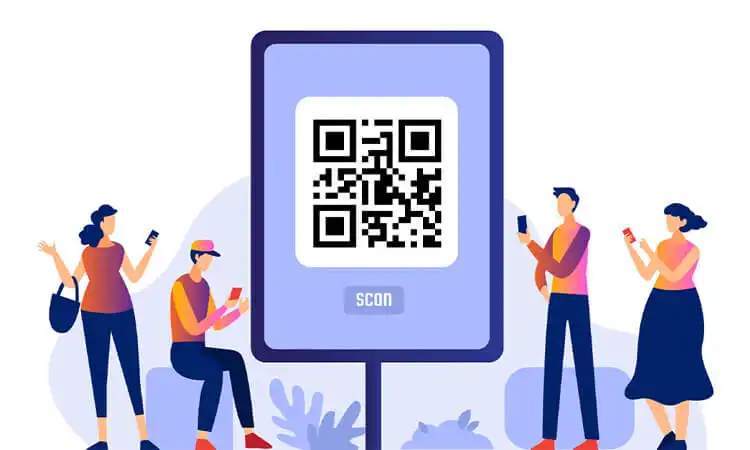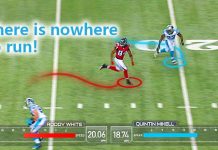QR code signage has become an increasingly popular tool in marketing campaigns. With its ability to link customers to relevant content, it’s no surprise that businesses are incorporating it into their advertising strategies. According to a study, QR code usage increased by 11% in 2021, showing that customers are receptive to this technology. In this artclie, we will explore the benefits of QR code signage for marketing campaigns and share tips for maximizing its potential.
What is QR Code Signage?
QR code signage is a modern type of signage that combines the physical and digital worlds. These signs come in various forms, such as posters, billboards, and decals, and can be customized with graphics and text. What makes them unique is adding a QR code – a type of digital barcode – somewhere on the sign.
How QR Code Signage Works
QR code signage is a type of two-dimensional barcode that can be scanned using a smartphone or other mobile device. Unlike traditional barcodes, which are one-dimensional and can only store a limited amount of information, QR codes can store much more data. This include text, URLs, and even multimedia content like videos and images.
When a QR code is scanned, it directs the user to a website, app, or other digital content. This can be a product page, a landing page for a marketing campaign, or a mobile payment platform. By scanning the QR code, users can access this content quickly and easily without manually entering a URL or searching for it online.
Basic Structure of a QR Code
QR codes consist of black and white squares arranged in a square grid. Each square represents a unit of binary code that a QR code scanner can read. The more squares in the QR code, the more data it can store.
QR codes can be designed in different sizes, depending on how much information they need to store and where they will be displayed. They can also be customized with different colors and shapes and incorporate logos or other branding elements.
If you are interested in QR codes, you can learn more through this article: Unveiling the Power of QR Code Labels
How QR Code Scanners Work
QR code scanners use a smartphone or mobile device camera to capture the QR code image. Then, the scanner interprets the binary code and directs the user to the corresponding digital content.
Most smartphones come with a built-in QR code scanner that can be accessed through the device’s camera app. However, many third-party QR code scanner apps are available for download that offer additional features and functionality.
Common Uses for QR Code Marking
QR code markings can be used for a variety of purposes in marketing campaigns, such as:
- Providing product information or reviews: QR codes can be placed on product packaging or in-store displays. This can direct customers to detailed product information, reviews, or instructional videos.
- Offering discounts or coupons: You can use QR codes to provide customers exclusive discounts, coupons, or promo codes that can be redeemed in-store or online.
- Enabling mobile payments: QR codes can be used to facilitate mobile payments. Thus, customers can pay for products or services directly from their mobile devices.
- Guiding visitors at events or tourist attractions: Most QR codes also can be placed on signage or maps to guide visitors to different attractions. These QR code signs can provide information about historical sites or offer language translations.
- Collecting customer feedback: You also can use QR codes to direct customers to surveys or feedback forms. This means it can help businesses to gather valuable customer insights and improve their products and services.
- Directing users to social media accounts or websites: QR codes can direct customers to social media accounts, websites, or landing pages. These QR codes sign for businesses and allow them to increase their online presence and engagement.
Related Articles:
QR Code Signage vs. Traditional Barcodes
QR code signage differs from traditional barcodes in several ways. Traditional barcodes are one-dimensional and can only store a limited amount of information. QR codes are two-dimensional and can store much more data. QR codes can also be scanned from a greater distance and designed in different colors and shapes. These features make them more versatile than traditional barcodes.
Here’s a table comparing QR Code Signage and Traditional Barcodes:
| QR Code Signage | Traditional Barcodes | |
|---|---|---|
| Information Capacity | High capacity, can store up to 7,000 characters | Low capacity, can store up to 20 characters |
| Scanning Speed | Fast, can be scanned in less than a second | Slow, requires a steady hand and good lighting |
| Ease of Scanning | Easy to scan with a smartphone camera | Requires a dedicated barcode scanner |
| Design Flexibility | Flexible, can be printed on any surface and in any size | Limited, must be printed on a specific type of label or surface |
| Error Correction | Can correct up to 30% damage or distortion | No error correction capability |
| Security | Can be encrypted for added security | No encryption capability |
Here we have a detailed analysis of QR codes and bar codes: QR Code vs Barcode: A Comprehensive Analysis
Advantages of QR Code Signage
QR code signage offers several advantages for businesses, including:
- Affordable and easy to create: QR codes can be created using free online tools or QR code generator software. It can be printed on various materials, including paper, plastic, or metal.
- It can be used for various purposes: QR codes for everything from product information and customer feedback to mobile payments and social media engagement.
- Provides an engaging way to connect with customers: QR codes offer a fun and interactive way for customers to engage with a business’s marketing campaign. This allows them to access digital content and discounts easily.
- Provides valuable data insights: By tracking the number of scans and the types of content accessed through the QR code, businesses can gather valuable data insights on customer behavior and preferences.
- Saves time and reduces friction: QR codes eliminate the need for customers to enter URLs or search for digital content manually. This makes it quicker and easier for them to access the information they need.
Best Practices and Tips for maximizing QR code Signage and usage
If you’re looking to create effective two-dimensional code signage for business, there are several best practices and tips you should keep in mind:
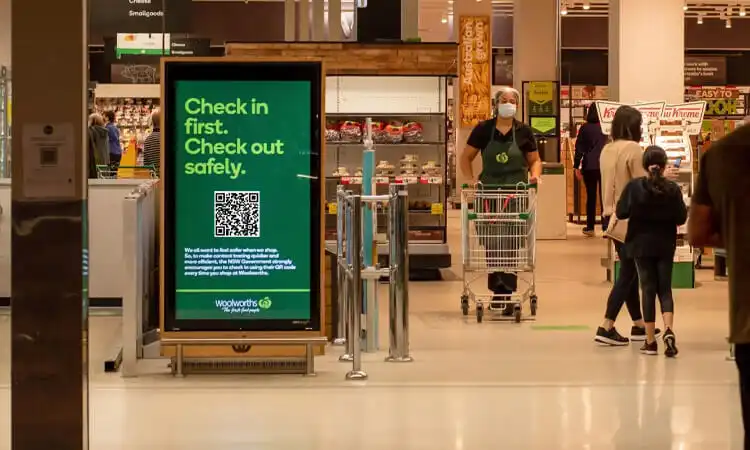
Keep QR Code Signage Simple
It is recommended to keep the design simple and uncluttered to maximize the effectiveness of two-dimensional barcode signage. The QR code should be the focal point of the signage, with minimal distractions in the background. Avoid including too much text or imagery around the QR code, as this can make it harder for customers to scan it.
Ensure High-Quality
QR codes should be printed at a high resolution on quality materials to ensure scannability. Low-quality printing can result in distorted or unreadable QR codes. This will frustrate customers and render the signage ineffective.
Test Scannability
Before deploying your two-dimensional code signage, you must test the scannability of the QR code using multiple devices and QR code scanner apps. This can help identify any issues with the design or printing that could affect its performance.
Provide Clear Instructions
Your 2D code signage should include clear instructions on how to scan the QR code and what the customer can expect to find after scanning it. This can help encourage customers to scan the code and increase the likelihood of a successful interaction.
Use a URL Shortener
A URL shortener can create a shorter, more readable QR code that is easier to scan and track. This can be particularly useful when including QR codes on smaller items, such as business cards or promotional items.
Provide Value to the Customer
Providing clear value to the customer is recommended to encourage them to engage with 2D code signage. This could include exclusive discounts, access to valuable content, or the ability to complete a mobile payment transaction easily.
Incorporate Branding
Your QR code signage should incorporate branding elements like logos or color schemes. A unique logo will reinforce brand recognition and enhance the overall aesthetics of the signage. This can help customers associate the QR code with your brand and increase the chances of a successful interaction.
Place Signage Strategically
QR code signage should be placed where customers will likely see it. These include product packaging, in-store displays, or outdoor advertising. This could include product packaging, in-store displays, or outdoor advertising. By placing the signage in locations where customers are likely to see it, you can increase the chances of successful interactions.
Monitor and Analyze Performance
It’s important to track and analyze performance metrics to measure the effectiveness of two-dimensional barcode signage. This could include the number of scans, the types of content accessed through the QR code, and customer engagement rates. By monitoring and analyzing performance, businesses can identify areas for improvement. It also lets them can make data-driven decisions to enhance the effectiveness of their QR code marketing campaigns.
You can make sure your barcode is valid by testing it step by step in this article: How Do I Perform a QR Code Test?
Examples of successful QR Code Signage Marketing Campaigns
QR codes have become a popular marketing tool for brands to engage with their customers. This section will explore some successful QR code marketing campaigns that have helped brands increase their visibility and engage their audience.
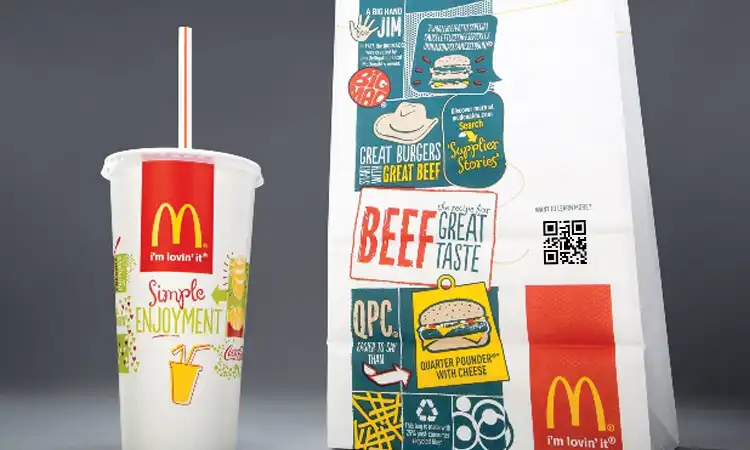
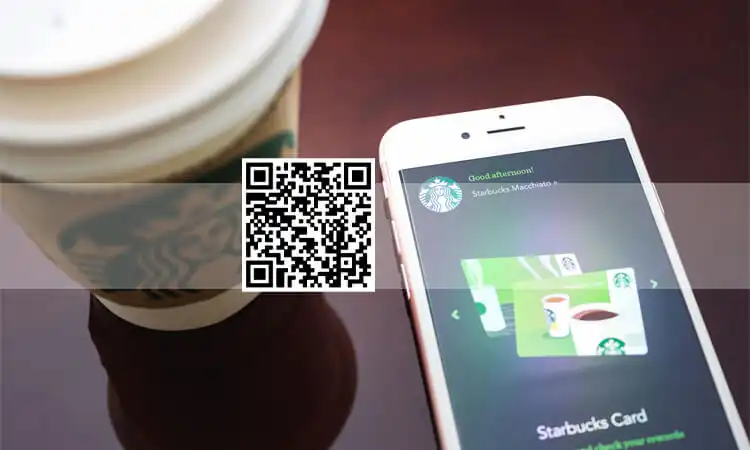
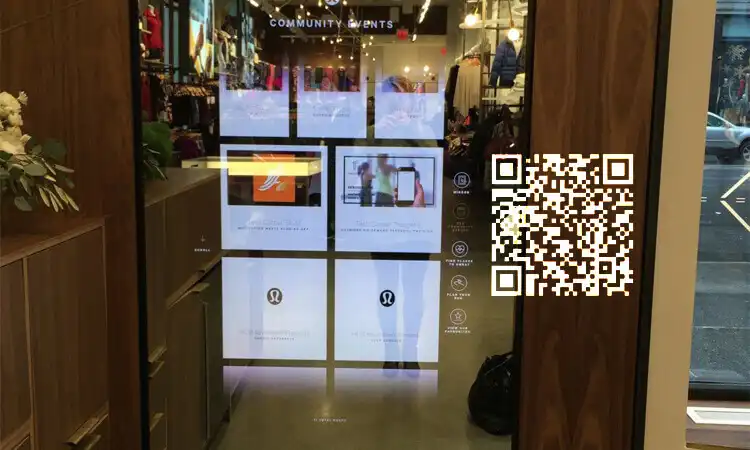
McDonald’s “Win When the USA Wins Gold” QR Code Signage Campaign
In 2012, McDonald’s launched a successful QR code signage campaign called “Win When USA Wins Gold.” The campaign encouraged customers to scan QR codes on McDonald’s cups and food packaging to access exclusive content, such as athlete interviews and training tips. Customers were also entered into sweepstakes for a chance to win prizes each time the US won a gold medal at the London Olympics.
Heinz’s “Get Well Soup” QR Code Signage Campaign
In 2019, Heinz launched a clever QR code signage campaign in the UK called “Get Well Soup.” The campaign allowed customers to scan a QR code on Heinz soup cans to access a digital “Get Well Soon” card. Then, they could personalize and send it to a sick friend or family member. The campaign was a hit on social media, with many customers sharing photos of their personalized cards.
Starbucks “My Starbucks Rewards” QR Code Signage Campaign
Starbucks has also used QR codes in several successful marketing campaigns over the years. In 2011, the coffee giant launched a “My Starbucks Rewards” campaign that encouraged customers to scan QR codes on their receipts to earn points toward free drinks and food items. The campaign was a hit, with millions of customers signing up for the rewards program.
Lululemon “Mirror and More” QR Code Signage Campaign
In 2020, Lululemon launched a successful QR code signage campaign called “Mirror and More.” The campaign encouraged customers to scan QR codes on Lululemon products to access exclusive content, such as yoga and meditation classes. The campaign was particularly successful during the pandemic, as more customers sought at-home fitness solutions.
Nike “Nike Free Run+” QR Code Signage Campaign
Nike has also used QR codes in several successful marketing campaigns over the years. In 2011, the company launched a campaign called “Nike Free Run+.” This allowed customers to scan QR codes on billboards to access exclusive content and a chance to win free shoes. The campaign was a hit, with customers sharing photos of themselves scanning the QR codes on social media.
Potential Challenges and Solutions
While QR codes can be a valuable tool for businesses, there are also potential challenges to consider. Here are a few challenges and solutions:
- Low Awareness. One challenge is low customer awareness of QR codes and how to use them.
- Solution: Your QR code signages must include instructions or a brief explanation of how to scan the code on the signage.
- Poor Placement. QR codes placed in inconvenient or difficult-to-scan locations can deter customer engagement.
- Solution: Strategically place the signage in areas that are easily accessible and visible.
- Technical Difficulties. Technical difficulties, such as slow loading times or broken links, can frustrate customers and decrease engagement.
- Solution: Test the QR code and landing page multiple times to ensure functionality.
- Security Concerns. QR codes may raise security concerns if they direct customers to a potentially harmful or fraudulent website.
- Solution: Ensure the landing page is secure and trustworthy. It also gives customers a clear call-to-action that indicates what they can expect from scanning the code.
- Limited Analytics. QR code campaigns may have limited analytics. This makes it difficult to track engagement and ROI.
- Solution: Use a tracking system or analytic tool to monitor and track the campaign’s effectiveness.
By being aware of potential challenges and implementing these solutions, businesses can overcome obstacles and ensure the success of their QR code marketing campaigns.
The Future of QR Code Signage in Marketing
In my opinion, the future of QR code signage in marketing looks promising. With the rise of mobile technology and the increasing importance of contactless interactions, QR codes provide a convenient and accessible way for customers to engage with brands.
QR code technology is constantly evolving, with new features such as dynamic QR codes and the ability to track user behavior. As a result, QR code marketing campaigns are becoming more personalized and targeted, leading to increased engagement and higher conversion rates.
In addition, QR codes can be used in various industries beyond traditional retail, such as healthcare, hospitality, and transportation. As businesses continue to innovate and explore new ways to use QR codes, the potential for growth and success is endless.
I believe that QR code signage is a powerful tool that can greatly benefit modern marketing campaigns. By following best practices for design and usage, businesses can maximize engagement and drive conversions. I am excited to see how QR technology will continue to evolve and provide even more innovative uses for 2D code signage in the future. Personally, I highly recommend incorporating two-dimensional barcode signage into your marketing mix, as it can give your business a competitive edge in today’s digital landscape.
- Related Articles: QR Code Alternatives 2023
More About QR code signage FAQs
-
What are some benefits of using QR code signage for marketing?
QR code signage can help to increase customer engagement and drive traffic to your website or social media pages. It can provide customers with a more convenient and interactive experience.
-
How can I make my QR code signage more effective?
Using a clear and easily scannable design is important to make your QR code signage more effective. You must provide a clear call to action and offer an incentive or reward for scanning the code.
-
How can QR code signage be used in the retail industry?
QR code signage can be used in the retail industry to give customers access to product information. It can offer digital coupons or discounts and allow customers to buy directly from their mobile devices.
-
Can QR code signage be used for event promotion?
Yes, QR code signage can be used for event promotion by providing attendees with access to event schedules, maps, and other important information and offering special promotions or discounts.
-
How can QR code signage be used in the restaurant industry?
QR code signage can be used in the restaurant industry to provide customers with access to menus, nutritional information, special offers or promotions and facilitate online ordering or reservations.


